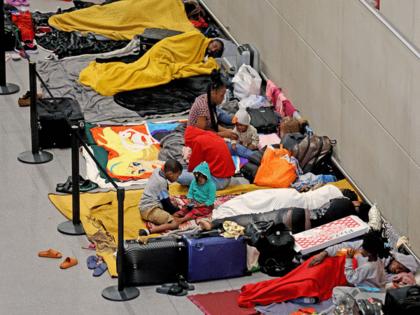Number of families, migrants in Massachusetts shelters down 30%, data shows
Published in News & Features
BOSTON — The number of families in taxpayer-funded emergency shelters has dropped dramatically after peaking at more than 7,600 households in July 2024, a level that pushed the system to a bursting point and drained hundreds of millions in one-time cash the state had set aside.
Providers said the reduced number of families in shelters is a result of restrictive policies put in place over the past year by Gov. Maura Healey and legislative Democrats. But Republicans also point to the Trump administration’s moves to clamp down the southern border.
Demand for the program first started to surge in the fall of 2022 amid an influx of newly arrived migrants to Massachusetts. But as costs to run the system increased, Beacon Hill Democrats eventually limited who and for how long homeless families could stay in temporary shelters.
Those decisions appear to be having the intended effect of curtailing the number of people in shelters, with a 30.4% drop between July 2024 and March 27, according to data on the total number of households in the emergency assistance program.
Danielle Ferrier, the CEO of shelter provider Heading Home, said her organization started seeing a decrease at the “front door” of the system last fall, including a boost in long-term Massachusetts residents seeking shelter over newly arrived migrants.
Ferrier, whose organization runs an overflow shelter in Norfolk, said she attributes the recent decrease to the “governor and our state legislators’ policy changes.”
“The Legislature and the governor have clearly leaned into adding tools and flexibility for how we help house folks, and all of those changes and cumulative impact, we are seeing work,” she told the Herald. “You’re starting to see that impact of how all those moves are helping us get folks out and bring the numbers down, which we knew we needed to do.”
At its peak, the emergency assistance shelter program housed 7,625 households — likely tens of thousands of people — at the end of July 2024, according to state data.
That was a massive spike compared to the 5,388 households in the system at the end of July 2023 and the 3,181 households in shelters at the end of July 2022, the state data showed.
Beacon Hill Democrats and Republicans have largely agreed that the rapid rush of demand was because of thousands of families arriving in Massachusetts from other countries in hope of shelter. Crushing housing costs and general cost of living increases also played a role.
The overwhelming desire for shelter led to a system that cost taxpayers $894 million to run in fiscal year 2024, and expenses are expected to surpass $1 billion in fiscal year 2025, according to a state report released earlier this month.
In November 2024, after about a year of the system hovering around 7,500 families, the number of households in shelter started to steadily decline. As of March 27, there were 5,309 families in the state-run emergency assistance program, according to state data, a 30.4% drop from last July.
Even with the smaller figures, the Healey administration does not yet know how much the emergency assistance program will cost in fiscal year 2026, the state report released this month said.
The reduced caseload comes after Healey and the Legislature signed off on a series of measures they argued would lower the number of families in shelter but advocates often criticized could create the potential for people to find themselves without a roof over their head.
As cases were on the rise in August 2023, Healey declared a state of emergency and called on the federal government to shuttle dollars to the state. She later activated the National Guard and implemented a 7,500 cap on the number of families in shelter, a move that survived a court challenge.
Months later, in April 2024, lawmakers signed off on their first major revisions to emergency shelters — a nine-month time limit on families’ stay in the system and new compliance measures to ensure households were working toward stable housing.
Later in the summer of 2024, Healey rolled out rules that prioritized Massachusetts families over migrants for placement in shelters, implemented a five-day stay at overflow sites, and required people to wait six months before they qualified for a longer-term shelter.
Healey announced in November 2024, when there were roughly 7,300 families in shelter, that the system would shift to two options — a “rapid shelter” track offering 30-day stays and a “bridge” track that would give “high-risk families” six months.
The six-month limit would eventually be approved in February, when the system’s caseload was hovering around 6,000 and Healey signed a bill that also blocked out anyone who was not lawfully present in the United States and capped the system at 4,000 families starting in December.
After years of changes, the Healey administration now contends that 75% of eligible households seeking shelter are “Massachusetts families” and 53% of households in the system are “Massachusetts families.”
Massachusetts Coalition for the Homeless Associate Director Kelly Turley said the decision to create two shelter tracks, which took effect in December 2024, was one of the most impactful policy shifts.
“In December, when they launched that two-track system, it was that the state was deciding for families which track they were on, and except in very limited situations, families couldn’t switch tracks, so the majority of families aren’t deemed to have a priority,” Turley told the Herald.
Turley also said declining numbers of families in shelters does “not necessarily correlate with a decrease in family homelessness or decreased need for shelter.”
Not everyone is celebrating the success of fewer people in state-run shelters.
Sen. Ryan Fattman said the Healey administration “refused to do anything” to contain the cost of the emergency assistance program when demand was surging in 2023 even as conservatives offered ideas.
The Sutton Republican also pointed to a series of arrests inside state-run shelters, like police taking into custody a man illegally in the United States from the Dominican Republic who was allegedly found at a Revere site with an AR-15 and $1 million worth of fentanyl.
That arrest, along with others, and the publication of a series of reports on disturbing incidents inside shelters have created a fervor over safety in shelters and prompted Healey to put in place a series of measures aimed at boosting security.
“It’s a system that became overwhelmed because of inaction, and now certain things are starting to be put in place. But at the same exact time, the federal policy has changed completely. So yeah, no duh, the numbers are going down,” Fattman said in an interview.
The declining number of families in the emergency assistance program has also prompted an uptick in the number of households exiting shelters.
Mark DeJoie, the CEO of the Lynn-based nonprofit Centerboard, said his organization that serves the shelter system has had a record number of monthly family placements into post-shelter housing, including 500 last year and 91 in December alone.
“Nobody ever moves in December. It never happens,” he said in an interview. “Something happened with the approach that is reducing the numbers at a pace that I would not expect. I think that I’ve been around as long as anybody in the profession. I wasn’t expecting this pace. I’m happy it’s happening. But I was not expecting this pace.”
Indeed, the number of families who are exiting emergency shelters each month has increased, according to the data set provided by the Executive Office of Housing and Livable Communities, which functions as Massachusetts’ housing department.
The earliest data provided by the department shows 134 households exited shelter in January 2023. That jumped to 213 in January 2024 and then spiked again to 717 in January 2025, according to the data.
A spokesperson for the housing department said the number of exits from shelters has increased “as a result of a series of steps” that the administration has taken, including setting up clinics to help people obtain work authorization and standing up a “dedicated” team to help people find jobs.
Ferrier, the CEO of shelter provider Heading Home, said the changes over the past several years have created “a different accountability structure” for providers, state government, and families who are trying to move through the system.
That, she said, is how “you see a system become a better system.”
“It becomes clearer what needs to be fixed, what needs to be adjusted. So I do think that part I have very much been in support of because I felt like it was the next iteration of our system advancing and becoming a more sophisticated, more effective system,” she said.
----------
©2025 MediaNews Group, Inc. Visit at bostonherald.com. Distributed by Tribune Content Agency, LLC.










Comments